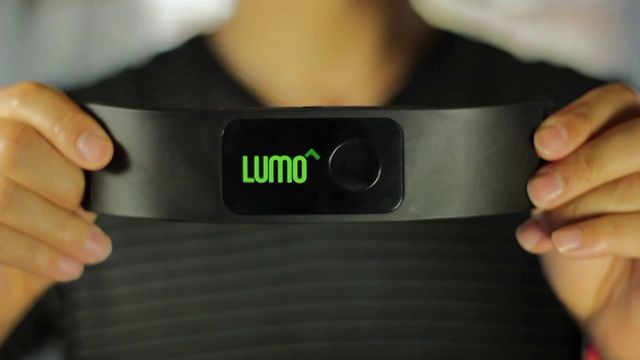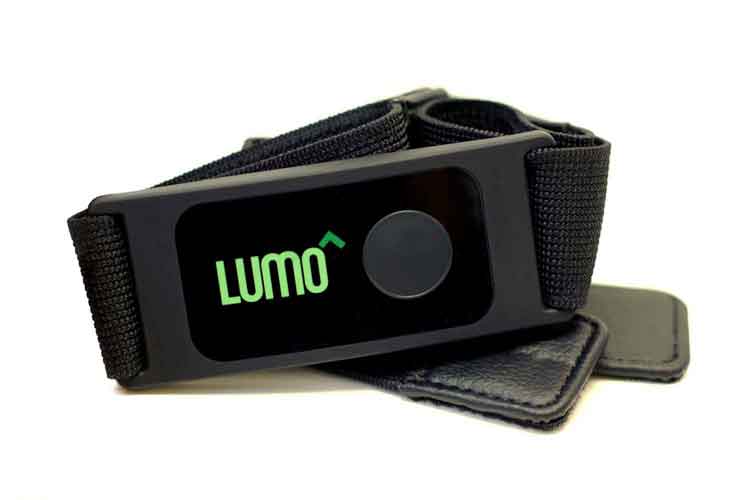I know I’m not alone when I say that I look like Quasimodo when using my laptop. Its not just my laptop: it’s also whenever I use my smartphone and tablet too. Our tech is turning us all into hunchbacks.
It’s about time that tech offers up a solution to this posture epidemic.
The LUMOback posture and movement sensor is like having your Mom constantly nagging you to sit up straight. The wearable sensor fits snuggly on your lower back and vibrates whenever you slouch. It’s pretty much just as annoying as your Mom, which means it works.
LUMOback sits alone in the activity tracker category of wearable tech both in its form factor as well as its capabilities. Unlike others in this space, like Nike’s Fuelband and Fitbit’s Flex, LUMOback is a belt that goes around your waist rather than a bracelet that you wear on your wrist. As well, it goes way beyond the step counting and calorie tracking of the others, measuring posture, activity and sleep in addition.
The belt that goes around your waist is elastic and fastens using Velcro, making it completely adjustable for any body type. It allows the reasonably small aerodynamic looking sensor to sit nicely on your lower back either under you clothes or over it. I usually wear mine under my clothes so that when I leave the house and go about my day, people don’t know I’m wearing it. I still don’t feel the belt is comfortable enough to wear on a daily basis but it becomes less noticeable as the day goes on.
The sensor pairs with the LUMOback iOS app (sorry Android folks, no love for you here. I know, I was upset too). It’s in the app that you’re able to set up the sensor. One of my biggest pet peeves with activity trackers today is that there’s usually no calibration during the setup that tries to get to know me. I was extremely pleased to see that a calibration sequence is necessary to start using LUMOback.
After doing a series of standing and sitting positions while wearing LUMOback, the device is ready to go and you will immediately know it is working because every time you slouch, you’ll get zapped back into position.
The vibration can get very annoying. But again that’s, the point. The app does let you change the intensity of the vibration so it’s less like an electric shock. It also lets you change the frequency of the sensation to either continually pulse when you are within your configured slouching threshold, or to only buzz once each time you move into a bad posture.
Even though I am not a fan of going out to market with only an iOS app, I have to say that it’s in the app that LUMOback really shines. The app features a stick person that mirrors your movement. It’s eerie and awesome at the same time. But the bottom line is it’s just as effective at getting you to sit up straight as the zap the sensor gives off when you get out of alignment. Watching yourself start off as a perfectly aligned green coloured stick person turn quickly into an angry red hunchback will scare you straight.
The avatar also mimics your movement. If you are standing, it stands. If you are walking, it walks. It even picks up the pace and runs with you when you are jogging. LUMOback also detects when you are driving, showing your little stick person cruising in its own vehicle in car mode. The mirroring works pretty well most of the time. I have had some regular issues with the avatar thinking that I am still standing when I had been sitting for a while. And as I am a knee bouncer, I keep causing LUMOback to think that I am in a car when I am still in the office working.
As LUMOback’s sensor can tell if you are standing, sitting, running, walking and even sleeping, this wearable tech is the only activity tracker right now that is able to quantify your entire day and night. This is why it’s my favourite of the bunch.
Having the sensor on your back rather than on your wrist also reduces the ability to falsify the movement being tracked by the device. I tested LUMOback against Fitbit and Misfit Shine and found the accuracy of steps tracked was much greater with LUMOback, especially when I had stopped moving. Fitbit and Misfit would continue to track my activity in a stationary position if I actively used my hands which triggered the sensor on my wrist.
The app also provides you with charts and scores to help you keep track of your progress. I’m a huge fan of how LUMOback can tell me how long I sit and stand over the course of a day, week or month – especially since they say sitting is the new smoking when it comes to leading cause of death (gulp).
Although I did wear LUMOback to bed a couple of times I’m not sure if it’s something I would be able to keep up. That being said, LUMOback is able to tell when you are in a sleep position, and automatically starts to track the time you slept. More impressive is its ability to track the position you were in during your slumber. Most other devices that track sleep do not do so automatically and only go as far as tracking your movement not your position so this is another advantage over the competition.
LUMOback is a little pricier than some of the other activity trackers out there. The device sells for $149.95 compared to the Fitbit Flex at $99.99 and even the Misfit Shine at $119.95. But having used all three of these, I would definitely say you get your bang for you buck with LUMOback. If you are keen on improving your posture and are cool with wearing a belt all day, this wearable is for you.



